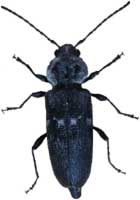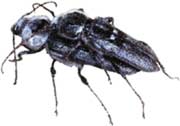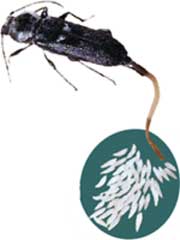|
|
|
| |
Old House Borer (Hylotrupes bajulus)
The Old House Borer
belongs to the beetle family Cerambycidae, a group also known as the "long
horned" beetles. The key-identifying characteristic of this family
is long, thin antennae that are often as long (or longer) than the body of the
beetle. The beetle's
body has a slightly flattened appearance. Its colour may appear dark grey, but
is usually brownish black to black. The prothorax (behind the head) is
rounded in shape and contains two raised, shiny black "bumps." The wing
covers of the old house borer are black, with lighter grey coloured areas
forming bands that are usually present about one-half down the wing covers.
Yellowish-grey hairs may be present on the head and the prothorax. |
|

|
|
Old
house borers attack softwoods
(pine, fir and
spruce) only, commonly used in building
construction. But they can also be found below and in the bark of oak, beech and
other hard woods logs and firewood. Adults emerge from infested wood from May
and continue into June or even July, depending on a climate conditions. The body
length of the adult old house borer males is
1.2 - 3.5 mm, and the females 2.8 - 4.6. Lifetime of adults is typically a few
weeks, but may vary from 1 - 4 weeks depending on the ecological conditions. |
|

|
|
Soon after mating
the female deposits several batches of eggs in softwood cracks. Female can
extent the ovipositor up to 35 mm and allows egg laying in cracks more than 42
mm deep. The eggs pass down the ovipositor in 3.3 to 11 seconds. The number of
eggs laid per female varies about 170. It depends on the size of the Hylotrupes
larva. Hylotrupes bajulus is sensitive to geomagnetic field. When reduce
horizontal component of geomagnetic field, development and egg production
increased. An area with an enlarged horizontal component of geomagnetic field
decreases egg production. Parthenogenesis produces males. The ratio of females
to males was 9:1, but may vary. |
|

|
|
The eggs hatch in
about 23 days at 28°C average, but at lower temperature it takes longer. New
larvae immediately bore into the softwood wood for 2-7 years typically but with
ease conditions larvae could stays in the wood much longer, till 19 years
maximum (about 0.2% of population). The full-grown larva (200–500 mg) tunnels to
the surface of the wood and cuts an oval hole (known as exit hole), which is 0,6
cm to 1,2 cm in diameter. Exit hole is sometimes sealed with packed frass. Just
below this exit hole is a pupation chamber where the larva pupate. The
pupation stage is initiated by a cool period and lasts 3-6 weeks. After that
period the pupa slough to a beetle, so life cycle of the old house borer has
been completed. |
|
 |
| |
| |
top
|
|



